The “Korean” government and the local governments adopt Japanese, while appealing for clearing up the colony times of Japan
October 21, 2020 Daily Shincho Sasaki Kazuyoshi
Original
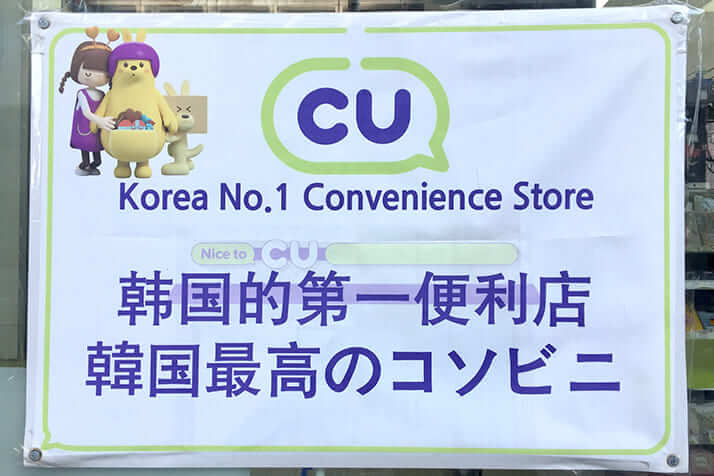
|
Right Japanese
|
There are a lot of mistakes. “コソビ二” is wrong, and “コンビニ” is right.
Renewal Kanji → Katakana
The Korean government and the ruling party appeal for “Clearing up the dregs of the Empire of Japan”, and the Seoul city changes Japanese notation into katakana, but it is hard for Japanese to read the enumeration of the katakana, and there is much wrong notation, too. Therefore the Japanese living in Korea does not read katakana but reads Korean or Chinese.
Four languages notation is a principle at the subway. Japanese was written in kanji before, but it is written now in katakana.
Both of 신천(Shin-cheon) Station and 신촌(Shin-chon) Station of Seoul subway Route 2 become “シンチョン” station in katakana.
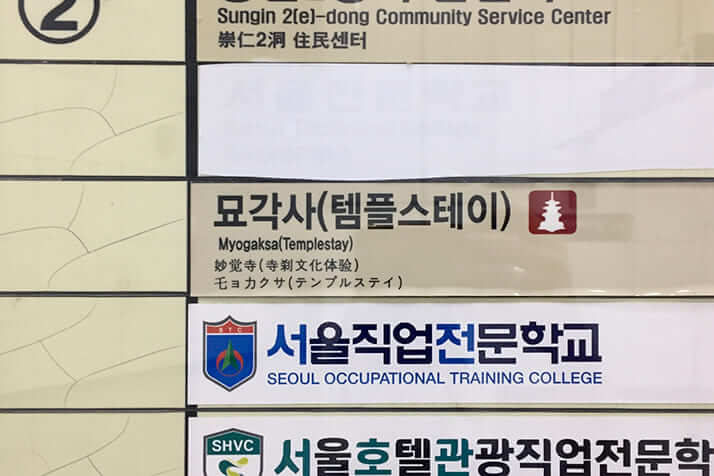
|
Right Japanese
妙覚寺(寺刹文化体験) |
Some letters are not Japanese. Not “乇ョカクサ”, but “ミョガクサ.” “乇” is not Japanese. “妙覚寺” is easy for Japanese to understand.
The Korean cannot know the history of their own country, because they cannot read kanji
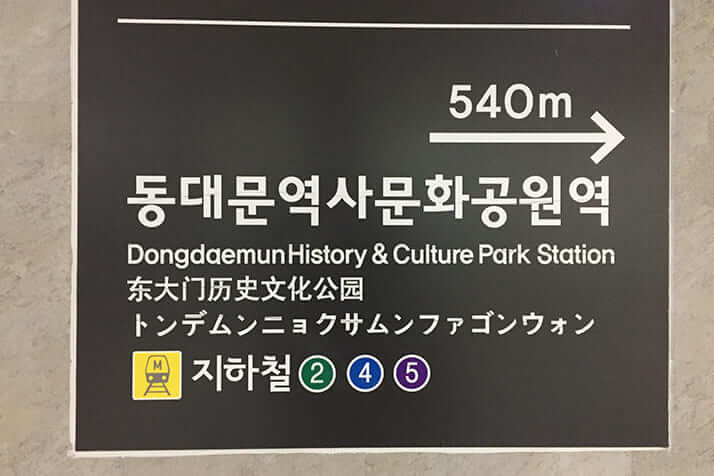
|
Right Japanese
東大門歴史文化公園 |
Four languages notation is a principle at the subway.
Tongdaemun market is known as a town of the fashion. The nearest station of the market is subway “Tongdaemun history culture park” station, but the katakana notation is “トンデムンヨッサムンファゴンウォン” or “トンデムンニョクサムンファファゴンウォン”.
The Japanese does not read katakana but reads Korean or Chinese.
It was thought that the kanji (Chinese characters) was transmitted in Japan from China and Paekche by the fifth century,
and hiragana letter and katakana were born by the Heian era (794-1192).
From the Kamakura era (1192-1333) to the Edo era(1603-1868), the samurai governments used KANJI/KANA mixed sentence as a virtual official language.
As the modern Japanese can understand the documents written in the Edo era from the Kamakura era through reading the original texts, they can know the right history.
On the other hand, the Korean cannot know the history of their own country, because the documents in the Korean Dynasties period were written in kanji and the Korean cannot read them.
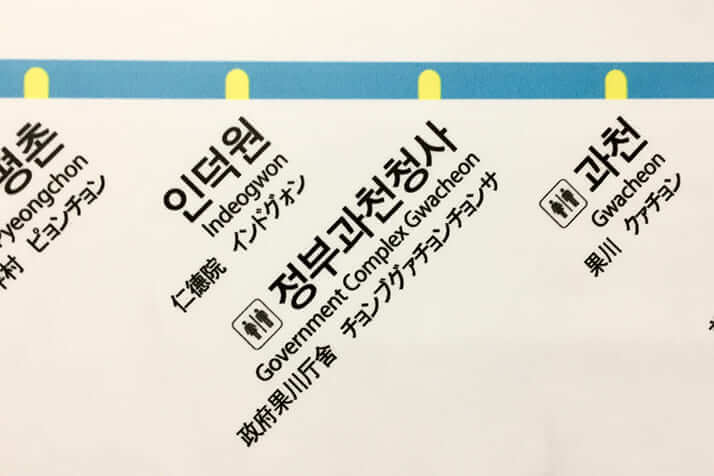
|
Right Japanese
政府果川庁舎 |
The Japanese will refer to Chinese.
The Korean accents of the Japanese kanji overflow
In the Meiji era Japan began to have relationship with United States and Europe
and Japan produced new Japanese words that expressed culture brought by Europe and America in one after another, and exported them to Korea and China.
Let’s see “中華人民共和国” (People’s Republic of China). “人民” and “共和国” are Japanese words.
Japanese made “人民” as an equivalent of “People” and “共和国” as an equivalent of “Republic”.
“朝鮮民主主義人民共和国” (Democratic People’s Republic of Korea) and “朝鮮労働党” (Workers’ Party of Korea) are also Japanese kanji words except “朝鮮” (Chosun).
There were not Japanese and Chinese words to be equivalent to “advertising” and “propaganda”, so Fukuzawa Yukichi made the new words for them. He translated “advertisement” as “広告” and he translated “propaganda” as “宣伝”, and they reached Korea and China.

|
Right Japanese
東大門歴史文化公園 |
Japanese can not know what “トンデムンニョクサムンファゴンウォン” means. “東大門歴史文化公園” is easy to understand.
“선전” is seldom seen in Korea, but “광고” is used widely.
The railroad terms are Japanese words on parade. It was the beginning of the Korean railway Shibusawa Eiichi tied up Incheon and Hanseong (current Seoul). Anywhere in the station, you can see the Korean accents of the Japanese kanji such as 기차 (train), 개찰 (wicket), 입구 (entrance), 출구 (exit), 수화물 (baggage), 수취 (receipt), 취급 (forwarding agent), 취소 (cancellation), 할인 (discount), 특급 (limited express), 급행 (express), etc..
In addition, Korean words used on a daily basis such as 개인 (individual), 의무 (duty), 연필 (pencil), 전화 (telephone), 비행기 (airplane), 신문 (newspaper), 철학 (philosophy), 환경 (environment), 화학 (chemistry), 과학 (science), 예술 (art), 사진 (photograph), etc. are Korean accents of kanji words made in Japan, and there are no Korean original words to replace them.
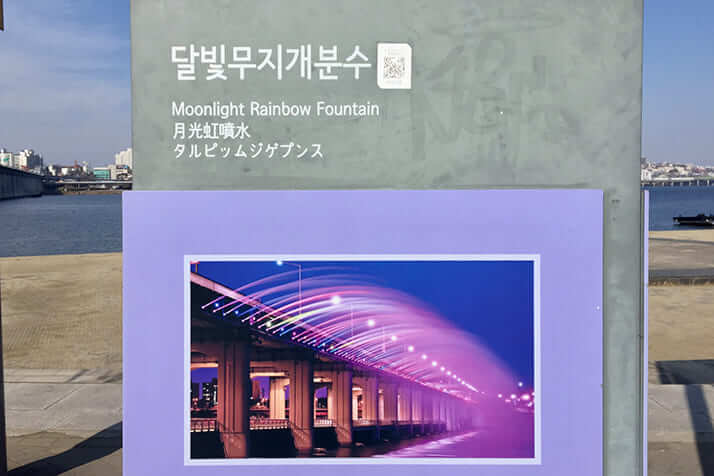
|
Right Japanese
月光虹噴水 |
“タルビッムジゲブンス” - Nobody can understand the meaning of the katakana.
Korean language has kanji words and the Korean original words. It is said that around 70% are kanji words and about 80% of them are made in Japan.
In other words, about half of Korean words come from Japanese.
The Korean government and Seoul city insist that they will get rid of the kanji words that Japan brought to Korea. But is such a thing really possible?
The rejection of the Japanese kanji causes the inconvenience and the overissue of the homonym.
The Korean government and local governments replace kanji words made in Japan with the Korean original words. For example “탑승입” changes to “타는 곳” (place to get on) and “출구” to “나가는 곳” (place to come out) . They profess to make the international cities, but they change the words to the expressions that are not in the dictionary. And that disturbs the trips of the Korean learners who are crazy about K-POP and visit Korea.
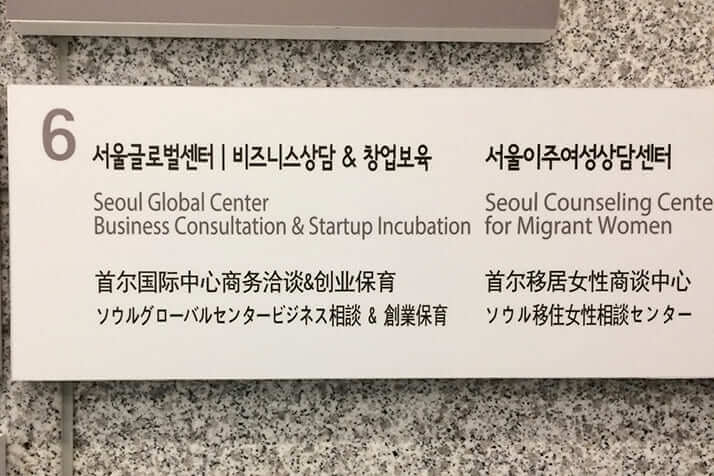
|
Right Japanese
|
This translates “incubation” as “保育” (childcare). “支援” is good.
In addition, there are very much homonyms. “会” is “회” and “長”, “葬”and “場” are all “장”. So “会長이 会葬의 会場에 간다” (“Chairperson goes to the venue of the funeral”) is written as “회장이 회장의 회장에 간다”.
“민주” (democracy) is a kanji word made in Japan of the Meiji era and “대통령” is the equivalent of the “president”, too
“근로(Keunro)” ⇒ “노동(Nodong)”
In December, 2019, the Gyeongsangnam-do assembly approved the regulations plan to change “근로” (work) into “노동” (labor).
In 2017 when the Democratic Party became the ruling party, Seoul city began to use the word “노동”, because “근로” was derived of Japanese rule. In March, 2019, the city officially announced the regulations lump reform bill that revised 53 regulations, and changed “근로” (work) to “노동” (labor).
In addition, the governors and the mayers who belonged to the Democratic Party, the ruling party such as Gyeonggi-do, Jeollabuk-do, Pusan city and Kwangju city followed that. But in the first place “働” is a kanji made in Japan. It is not a Chinese kanji.
“근로” (work) is an expression to be seen in the record of the Korea dynasty, and there was not a Diet member in the ruling party who could read the history books in the Korean Dynasties period, because they were written in Kanji, not Hangul.
The ruling Democratic Party and President Moon Jae-in are pushing forward clearing up the dregs of the Empire of Japan, but “민주” (democracy) is a kanji word made in Japan of the Meiji era and “대통령” was devised as an equivalent of “president” in the Edo era, too. It took a firm hold on Japan in Meiji era. Chinese is “総統” or “大総統”.
The ruling party must change the party name and Moon Jae-in must change his title, but “대통령” is fixed in the constitution. If they want to revise the constitution, they will have to change many laws.
In addition, “헌법” (constitution) and “법률” (law) of Korean words were brought by Japan for the rule era.
The government and the nation deny the history, and they also see no present, to say nothing of future.
(It is said that approximately 70% of Korean words are Japanese. Korea abolished the use of the Kanji (Chinese characters) not to need to be conscious of that. As a result, most of Korean people can not understand past historical materials now.)
The Korean famous novelist says, “If you go study abroad in Japan, you are pro-Japanese”
(Korea・JoongAng Ilbo) (October 12, 2020)
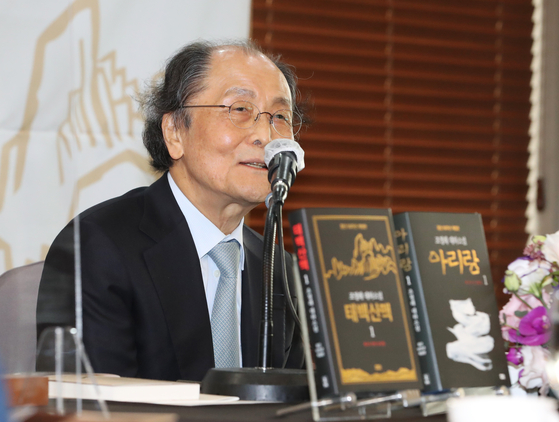
Jo Jung-rae, the Korean famous novelist
Jo Jung-rae who wrote the novels of “Taebaek Mountains” and “Arirang” said, “If you go study abroad in Japan, you are unconditionally a pro-Japanese and a traitor”.
In contrast, Chin Jung-kwon, the former professor at Tong-Yang University criticized that and said through his Facebook, “This level is insanity. A tendency of the extreme right latent in the anachronistic nationalism comes out without a principle.
Is “대통령 (president)” a Korean word ?
(Korea・ChosunIlbo) (July 14, 2019)
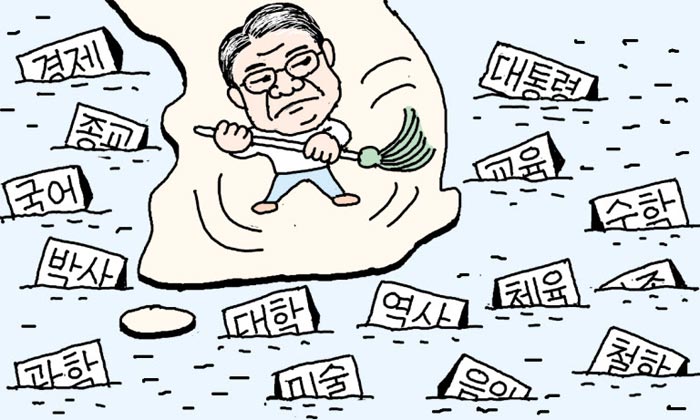
(illustlation:ChosunIlbo)
“Dictionary of Korean words derived from Japanese” has 3,634 Japanese words that have become Korean words since the 1880s. Approximately 90% of them are pronounced in Korean style. They are “교육 (education)”, “가족 (family)”, “국민 (nation)”, etc.. The remainder is pronounced in Japanese style. They are “모나카 (Bean-jam-filled wafers)” “만땅 (filled up)”, “무데뽀 (recklessness)”, etc..
The Gyeonggi-do Government Board of Education sent a document to the elementary schools, the junior high schools and the high schools in the area. And it pointed out that “단어 (the words) such as 수학여행 (school excursion), 파이팅 (fighting) and 훈화 (moral discourse) are the dregs of the Japanese imperialism, because they came from Japan”. The Board of Education asked children and students. “What do you (본인) think is the concept (개념) of the dregs of the Japanese imperialism? And how should you liquidate (청산) the problem?” However, “본인” “개념” “청산” in these sentences are the words that came from Japan. “단어” (word) is so too.
Ee Jae-jeong, the chairman of the Board of Education majored in German and German literature at a university and acquired a doctor degree in religion and theology in the graduate school. However, in fact, it is Japanese who translated “Deutschland” as “독일 (Dogil)”, and the words such as “대학 (university)”, “대학원 (graduate school)”, “신학 (theology)”, “종교 (religion)” and “박사 (doctor)” all came from Japan. “과학 (Science)”, “철학 (philosophy)”, “물리 (physics)”, “역사 (history)”, “미술 (art)”, “음악 (music)” and “체육 (physical education)” are all Japanese words, not to mention “국어 (national language), 영어 (English) and 수학 (mathematics)”. Besides, a Japanese translated “president” as “대통령”.
In the days of the Meiji Restoration, Japanese made an English-Japanese dictionary. Then they translated “liberty” as “자유”, and “economy” as “경제”. These words began to be conveyed to Korea later and large quantities flowed in forcibly in the era of Japanese imperialism. The words that Japanese translated entered Korea continuously after liberation too.
Now is the time people in the world have relationship with each other and exchange something through the Internet in real time. It is too natural that the words of various countries mix. They have completely become Korean and are used naturally without a feeling of incongruity or refusal. On earth what should we do, if we are ordered not to use Japanese words that are the dregs of Japanese imperialism.?
My Opinion
Clearing up the dregs of Japanese imperialism - “Juniperus chinensis” removal
(Korea・ChosunIlbo) (June 08, 2019)
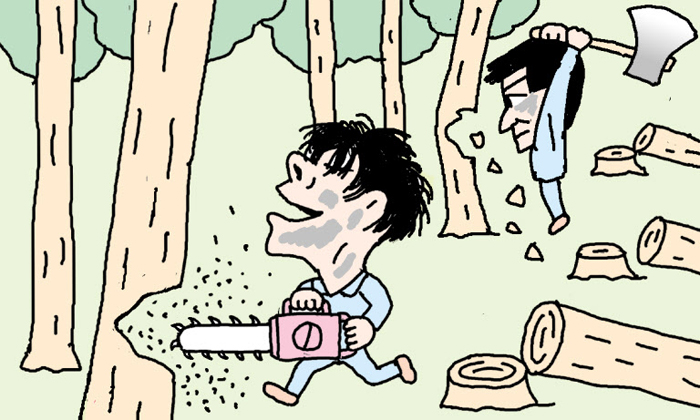
(illustlation:ChosunIlbo)
A tree of Juniperus chinensis was embroiled in controversy this time.
On June 3, Jeju-do assembly announced “Clearing-up plan of the dregs of Japanese imperialism”. The Board of Education in Jeju says “If the regulations plan passes, we will cut down the Juniperus chinensis planted on the campus, dregs of Japanese imperialism".
21 schools in total in Jeju Island appoint this tree as school tree. 2,157 Juniperus chinensis of school grounds are going to be cut down mercilessly.
The road names and the school songs were changed and this time a plant is attacked, because the President demands clearing-up of pro-Japanese.
It is 1928 that the tree name called Kaizukaibuki (Juniperus chinensis) comes up for the first time in Japan, and it is said, “there was not such tree as of 1909”.
Japanese book published in 1930 records that the Juniperus chinensis that Hirobumi Ito had planted disappeared completely.
The origin of the Juniperus chinensis is in Korea, Japan and China. They are multiple places. The Juniperus chinensis more than 500 years years old grow in Changdeokgung and Seonnongdan in Seoul.
On the contrary, the tree of cedar is a Japanese endemic species and Japan is the places of origin. It was brought into Korea in the colony times and was planted as windbreak forests in the fields, the orchard and around the village in Jeju Island. And it became the representative tree of Jeju.
If cutting down of Juniperus chinensis is right, you must cut down a cedar first. Jeju will go to ruin.
Till when must we watch such a wintry comedy?
My Opinion
Chunchon City removes the monument inscribed with a poem that praises Seo Jeong-ju, Choe Nam-seon and Cho Yeon‐hyeon for pro-Japanese.
(Korea・Chosun Ilbo) (May 01, 2019)

Chunchon literature park
On May 1, Chunchon City announced that it would remove the monument inscribed with a poem that praises Seo Jeong-ju, Choe Nam-seon and Cho Yeon-hyeon. The monument is installed in the literature park.
It’s because three men are listed in the pro-Japanese biographical dictionary.
The pro-Japanese biographical dictionary is edited by “the racial problem research institute” that is known as a left-winger citizen’s group.
My Opinion
However, in those days only one method for the development of the Korean literature was to learn Japanese literature. I am sorry that the people who devoted themselves to development of the Korean literature are assumed a betrayer and are put out in this way.
A tree with Japanese name removed in Korea because of “the dregs of the Japanese imperialism”
(Japan・Asahi Shimbun) (February 20, 2019)

Education Bureau of Gyeongsangnam-do (southeastern part of Korea) removed a Juniperus chinensis ‘Kaizuka’, an evergreen conifer of Japanese cypress in front of the Government building to another place by February 19.
According to a person concerned with the bureau, the Korean news “Juniperus chinensis ‘Kaizuka’ (Kaizukaibuki) is the dregs of the Japanese imperialism” influenced the decision.
The bureau planted a Korean pine in the site where Kaizukaibuki was removed.
“The news pointed out that it is not necessary the tree with the Japanese scientific name is in front of the center entrance, though we have the our nation’s own pine”.
My Opinion
Cabinet approves proposal to change date of National Railway Day
(韓国・The Korea Herald) (May 08, 2018)
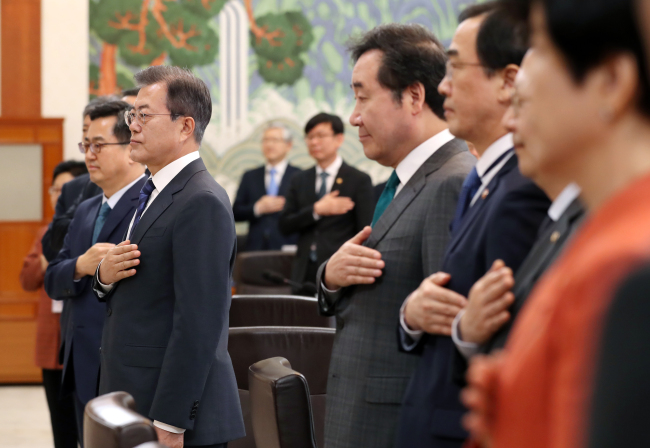
The Cabinet on Tuesday approved a proposal to change the date of National Railway Day -- designated in 1937 when Korea was under Japan's colonial rule -- amid criticism it is a vestige of the colonial occupation.
The Japanese colonial powers designated Sept. 18 as the railway anniversary to mark the 1899 opening of Korea's first railway, linking Seoul and the city of Incheon. Critics have called for the anniversary to be changed, as the Gyeongin Railway was a major means by which Japan exploited Korea.
On Tuesday, the Cabinet decided to move the anniversary to June 28 to mark the 1894 establishment of Korea's first railway agency during a meeting presided over by President Moon Jae-in.
It is the second time that the government of President Moon Jae-in has changed a national anniversary.
Last month, the Cabinet also decided to change the anniversary of the 1919 founding of Korea's provisional government in China to April 11 from the current April 13 in accordance with suggestions from historians.
These decisions have prompted speculation that the liberal Moon administration could also seek to change other anniversaries that were designated from a conservative point of view, such as Armed Forces Day, which marks South Korean forces' crossing of the 38th parallel border into the North during the 1950-53 Korean War.
Conservative critics say changing such anniversaries that have been observed for decades would be going too far.
My Opinion
Tong Vfang Xien Qi’s MV (Music Video) deletes Japan from a world map
(Korea・Insight) (April 03, 2018)

Japan was deleted in a MV (music video) of a piece of music “Love Line” by Korean popular music group “Tong Vfang Xien Qi”, and it became the topic between net users.
The entertainment office “SM entertainment” they belong to accepted this immediately and explained it with “a CG mistake” and said, “We began to correct the work”.
The office added, “We confirmed this mistake was the issue of CG editing of production company FantazyLab. We could not confirm it beforehand. We apologize to those who felt inconvenience heartily.”
The corrected MV was shown again at 4:00 on the afternoon of 3rd April.
My Opinion
Korean idol prohibited from broadcast for using Japanese
(Korea・Sports Korea) (September 27, 2017)

On September 27, 2017, Solo debut music of P. O who is a member of K-POP group “BlockB” was targeted for broadcast prohibition in Korean public broadcast station (KBS). It is said that it is caused by the fact that Japanese word was used in the lyric.
It is the P. O’s solo debut single “MEN’zNIGHT” that KBS prohibited the broadcast of the music. It became target for sanctions, because that the word “Pica” in the lyric of the song was Japanese-style expression.
|
MEN’Z NIGHT
Tell me what’s tonight Ladies’ night Ladies’ night Tell me what’s tonight Ladies’ night Ladies’ night 오늘밤은 무슨 밤 Ladies’ night Ladies’ night 오늘밤은 무슨 밤 shawty 삐까 (pica)뻔쩍한 오라버니 yeah I’m a pretty boy woo 내가봐도 looking good 인기 많은 바람둥이 막 날라 다니지 Hold up 왜 I’m too fly 넌 몰라 |
In the discussion in KBS, 14 songs received broadcast impropriety judgments. It was said that the rapper Crucial Star’s new song “야식 (Midnight Meal)” had a Japanese-style expression.
The dish name called “Tattoritang” in the song became the problem. It is a extremely common Korean dish using chicken. There is an opinion that the part of the lyric “tori” means “chicken” in Japanese.
|
야식 (夜食)
야식은 역시 너랑 먹어야 제 맛이야 벌써 삼일째 닭도리 (tori)탕을 시켜도 난 좋아 먹으며 뭐 볼 지 골라봐 정말 난 이 시간이 끝나지 않았으면 해 |
My Opinion
Korea cuts Japan off the world map - the official site of the PyeongChang 2018 Olympics
(Japan・Jiji Press) (September 27, 2017)
 |
→ |  |
| before correction | After correction (red parts were added) |
The world map is in the official site of the PyeongChang 2018 Olympics, but it did not have Japanese Islands and Sakhalin.
It is the English version page that introduces “Dream Programme” that provides youths aged 11 to 15 with the opportunity to train in skiing and ice sports.
The map includes the main islands such as Cuba, Madagascar, the Philippines, Sri Lanka and Indonesia, but Japanese Islands and Russian Sakhalin were cut off.
Korea received protest from the Japanese Government, and at about the midday of September 27, Japanese Islands and Sakhalin were added to the map.
But only the added parts are slightly unnatural because the method of drawing maps is different.

|

|

|
| before correction |
After correction (red parts were added)
The added parts are slightly unnatural because the different method of drawing maps is added. The correction is wrong too. |
Japan and Sakhalin by the correct method of drawing |
My Opinion

Japan is cut also in the world map of the official site of the PyeongChang’s bid to host 2014 Olympics. |

The poster of PyeongChang’s bid committee to host 2018 Olympics does not have Japan either. |

|

|
| The map of Samsung does not have Japan either. | The map of Samsung Galaxy Note does not have Japan either. |
| Samsung Galaxy Note - YouTube Movie - There is no Japan. | |
kindergarten (幼稚園 유치원) → kindergarten (幼児学校 유아학교) - long way to erase the remains of the rule era by Japan
(Korea・dongA Ilbo) (November 10, 2016)

20 years have passed since “national school (国民 学校 국민 학교)” that was the remain of the rule era by Japan was changed into “elementary school (初等 学校 초등 학교)” , but the liquidation of the remains of Japanese empire is still pushed forward in the educational world.
The name of “幼稚園, 유치원 (kindergarten)” is brought into question, because it’s a remain of the rule era by Japanese empire.
The name “幼稚園, 유치원” is the words that Japanese translated German word “Kindergarten” into.
In 2014 the infant education revision bill which renames “幼稚園, 유치원 (kindergarten)” to “幼児学校 유아학교 (infant school)” was proposed by a member of the ruling party, but it did not pass the Congress.
Things such as “朝礼台, 조회대 (platform for morning meeting)” also make you feel past Japanese militarism as well as names.
In addition, Hollywood juniper planted in the school grounds spread out in the whole country, since Hirobumi Ito who was a Korean supervisor planted trees in the parks in Taegu city in 1909. The education authorities instruct that schools that designate this tree as school tree change it to other tree and schools remove the trees.
My Opinion
Words of the Japanese origin in the table
| Japanese | Korean | English | ||
| letters | pronunciation | letters | pronunciation | |
| 教育界 | kyō-iku-kai | 교육계 | kyo-yug-ge | educational world |
| 日帝残滓 | nit-tei-zan-shi | 일제잔재 | il-je-jan-jae | remains of Japanase empire |
| 理由 | ri-yū | 이유 | i-yu | reason |
| 清算努力 | sē-san-do-ryoku | 청산노력 | cho-san-no-ryok | effort to clear |
| 幼稚園 | yō-chi-en | 유치원 | yu-chi-won | kindergarten |
| 名称 | mē-syō | 명칭 | myong-jing | name |
| 改称 | kai-syō | 개칭 | kae-jing | renaming |
| 東西南北 | tō-zai-nam-boku | 동서남북 | tong-so-nam-buk | north, south, east and west |
| 方位 | hō-i | 방위 | bang-wi | direction |
| 学校名 | gak-kō-mei | 학교명 | hak-kyo-myong | school's name |
| 初等学校 | sho-tō-gak-kō | 초등학교 | cho-deung-hak-kyo | kindergarten |
| 幼児学校 | yō-ji-gak-kō | 유아학교 | yu-a-hak-kyo | elementary school |
| 植民統治 | shoku-min-tō-chi | 식민통치 | sik-min-tong-ji | colonization rule |
| 便宜 | ben-gi | 편의 | pyon-ui | convenience |
| 方式 | hō-shiki | 방식 | bang-sik | method | 由来 | yu-rai | 유래 | yu-rae | origin |
| 改正 | kai-sē | 개정 | kae-jong | correction |
| 推進 | sui-shin | 추진 | chu-jin | promotion |
| 朝礼台 | chō-rē-dai | 조회대 | cho-hoe-dae | platform for morning meeting |
| 軍国主義 | gun-koku-syu-gi | 군국주의 | kun-guk-ju-ui | militarism |
| 文化 | bun-ka | 문화 | mun-hwa | culture |
| 関連 | kan-ren | 관련 | kwan-ryon | connection |
| 学生 | gaku-sē | 학생 | hak-saeng | student |
| 休憩 | kyu-kē | 휴게 | hyu-ge | break |
| 場所 | ba-sho | 장소 | chang-so | place |
| 代表的 | dai-hyō-teki | 대표적 | tae-pyo-jok | representative―typical |
| 造景樹 | zō-kei-ju | 조경수 | cho-gyong-su | trees making good scenery |
| 校木 | kō-boku | 교목 | kyo-mok | school tree |
| 交替 | kō-tai | 교체 | kyo-je | change |
- Words of “초등 (elementary)” , “학교 (school) and “유아 (infant)” are kanji words derived from Japanese words too.
- Korean net users sent various comments for this article as follows.
- “The remains do not disappear even if they change only the names” .
- “Do they abolish Seoul Univ. which Japan built too?”
- “연필 (Pencil), 경찰 (police), 소방서 (fire department), 병원 (hospital)” …These are Kanji words. Kanji words that mean things made in modern times are almost Japanese words. Do they change all? ”
- “사회 (Society), 경제 (Economy), all are Kanji words of the Japanese style. There are no bounds …. ”
- “I think that Korea is slightly too sensitive. You should not waste energy on useless things.”
- 70% of the Korean vocabulary come from Japanese. More than 90% of technical terms come from Japanese.
- They had used “Kanji” , but now they don’t because of their pride. They want to erase the history of Japanese reign. But that cannot erase the Japanese origin. Therefore they are going to replace them with original Korean words.
- However, it takes long time to change 70% of words and it is impossible to change words artificially. “新聞” (Shinbun) is the words that Japanese translated “Newspaper” into. “新聞” (신문) (Shinmun) is Korean word too. It is impossible to change that.
This time Korean paper attacks Japanese schoolchild's satchel. “It is the militaristic symbol”. (June 12, 2015)
(Korea・Chosun Ilbo)

"Randoseru(Japanese schoolchild's satchel) is a militaristic symbol, and the Korean should not use it". ---- Korean major paper "Chosun Ilbo" wrote such an absurd column and that is a topic in Korea now. While "randoseru" is becoming popular in Korea, being triggered by the habitual use of the European and American celebrities, he seems to want to give a warning.
"The Japanese militaristic vestige which still remains in Korea" The reporter Sun Ho-chol attached such a title to the column dated June 12, 2015. ■He criticized TV CM too where the child actor carried a "randoseru" on its back. The use of the "randoseru" began in the Edo era. Along with a wave of western reforms in the Japanese military, the Netherlands-style rucksack called "ransel" (Japanese: randoseru) was introduced as a new way for the foot soldiers to carry their baggage. In 1885, the Japanese government, through the elementary school Gakushūin , proposed the use of a backpack as the new ideal for Japanese elementary school students. It is said two years later that the present box-type was devised, and Hirobumi Ito who would be Japanese first Prime Minister gave the Prince the special order "randoseru" that imitated the rucksack of the military officer as the memory of elementary school entrance.
The reporter who wrote the column asserted his unique opinion, "the origin of 'randoseru' is to have taught the primary schoolchildren Japanese militaristic mind", after having introduced this origin. He introduced that Japanese TV program explained the ring of the metal on the side of "randoseru" had been a thing originally to hang a grenade. He added, "I imagine militarism whenever I watch Japanese children who carried "randoserus" on their back".
Korean TV broadcast the scene that a child actress carried a "randoseru" on her back in CM of the child service smartphone. The reporter added a false charge to CM and pointed out, "They would not have broadcast the Japanese militaristic symbol on the screen of TV if they had known the origin of 'randoseru'". He said that Japanese Kabuki was a militaristic symbol. And he criticized a Korean TV drama that used the term of Japanese Kabuki and he suggested, "How about thinking what a Korean does not know about Japan and Japanese militarism".
Since 2014 when an actress showed her photos of her carrying "randoseru", it has become a part of fashion for grown-up girls, especially for European and American celebrities who love "kawaii" items. Triggered by it, it increases that foreign tourists purchase "randoseru" as Japanese souvenir.
At the same time it has come to be sold in Korea and it becomes the popular item among primary schoolchildren recently. In March MBC TV(Korea) said that more than 100 "randoserus" were sold in the department stores and they were so popular that the high-priced "randoseru" worth more than 70000 yen were sold immediately.
The reporter saw the CM and thought to write this column.
It has become the topic on the net that a false charge was added to "randoseru".
"He adds a false charge to Japanese things that are popular in the foreign countries."
"Then does it mean a sailor suit worn by school girls and a jacket with a stand-up collar worn by school boys are no good too?"
"He will begin to insist on the origin of 'randoseru' soon"...
There seemed to be not a little Korean who thought that this column were funny.
The following comments had much support.
"Does he get on a train of Seoul metro Route 1, though it was made with the technique of Japan?"
"Does he want only a clannish thing?"
"The present readers do not expect such sentences."
My Opinion
The essence of the Japanese products is in a small product. (China・Today's News)
(Seachina)
The Chinese liked Japanese products of the large household appliance once, but now they buy the small products such as a nail clippers, a kitchen knife, a nursing bottle, the stainless steel thermal insulation mug in Japan and return home.
The tradition and the modern are fused in Japanese mosquito-repellent incense.
Non-inflammable fiber is used for the pad of the incense stick. and the fire goes out when it touches the edge of the can.
You can see the essence of "the made in Japan" in the precision of the small product.
Japanese is good at making a small idea in a product and is origin of the manufacturing industry of Japan.
Nambu ironware has become the product Chinese tourists want to buy.
By all appearance it is made precisely and really well, and you feel heavy when you carry it in your hand.
It takes two months for production of a Nambu ironware, and products are produced with careful work.
The schoolchild's satchel of the primary schoolchild is the most durable bag in the world.
It will not transform even if you use it for six years.
High quality and the beautiful form have fineness to remind of a Japanese car.
In addition, the consideration that the burden of the shoulder becomes light is given in functionality.
On the other hand, it ensures a storing capacity well.
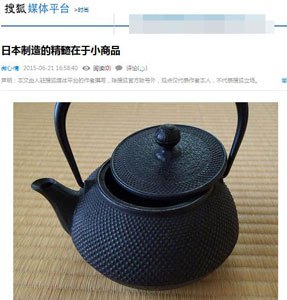
Korea declares the removal of "dregs of Japanese reign", but Seoul city is full of Japanese buildings ! (livedoor NEWS May 15, 2015)
Seoul city decides to change the Japanese style kanji words that are used for the administrative terms to the Korean style words. (Korea Joongang Daily April 12, 2015)

The National Tax Agency Namdaemun annex which
waits for the dismantling. It is said that it
had 4 stories before the remodeling in postwar.
-
According to the plan that Seoul city announced on May 6, National Tax Agency Namdaemun annex built in the Japanese rule times will be dismantled, and it will become the park.
"In commemoration of 70th anniversary of liberation, 'dregs of Japanese reign' are dismantled."――
But, in fact the right neighbor is the building of "dregs of Japanese reign" too. That was not announced by the news.
It is the Seoul municipal assembly hall since 1991, and it was registered with Korean cultural assets in 2002.
In fact, not only Seoul municipal assembly hall, the outskirts are full of the buildings of the rule era of Japan.
Seoul library (former Keijo prefecture building - Seoul city hall), new world department store head office (former Mitsukoshi Keijo shop), Myondong art theater (former Meijiza) and old Seoul station are no more than a single example.
Anything is saved as cultural asset or historic spot. -
According to the announcement of Seoul city on May 10, the city will change the 23 Japanese style kanji words that are used for the administrative terms to the Korean style words.
Kim Jin-man who is the citizen attache of Seoul City said, "we opened the meeting of the committee, and chose the words to purify".
My Opinion